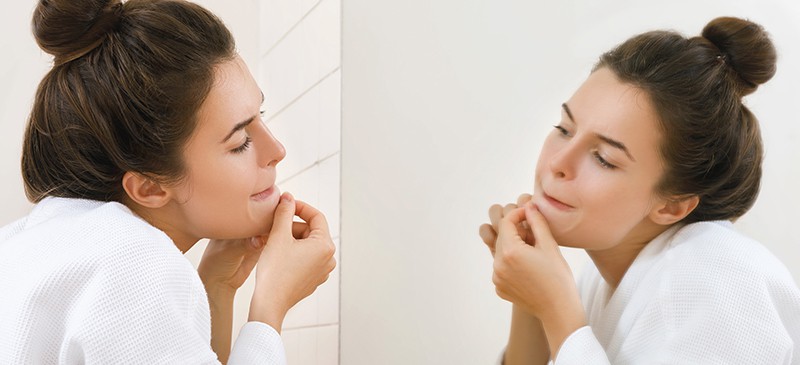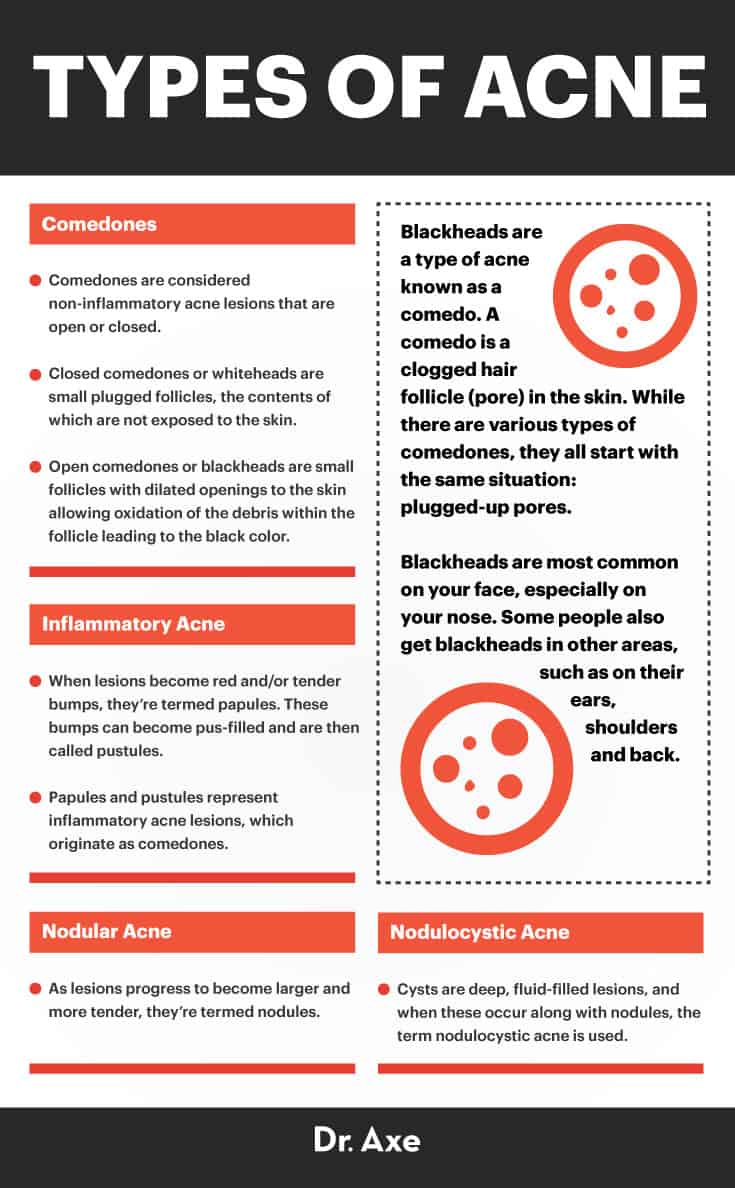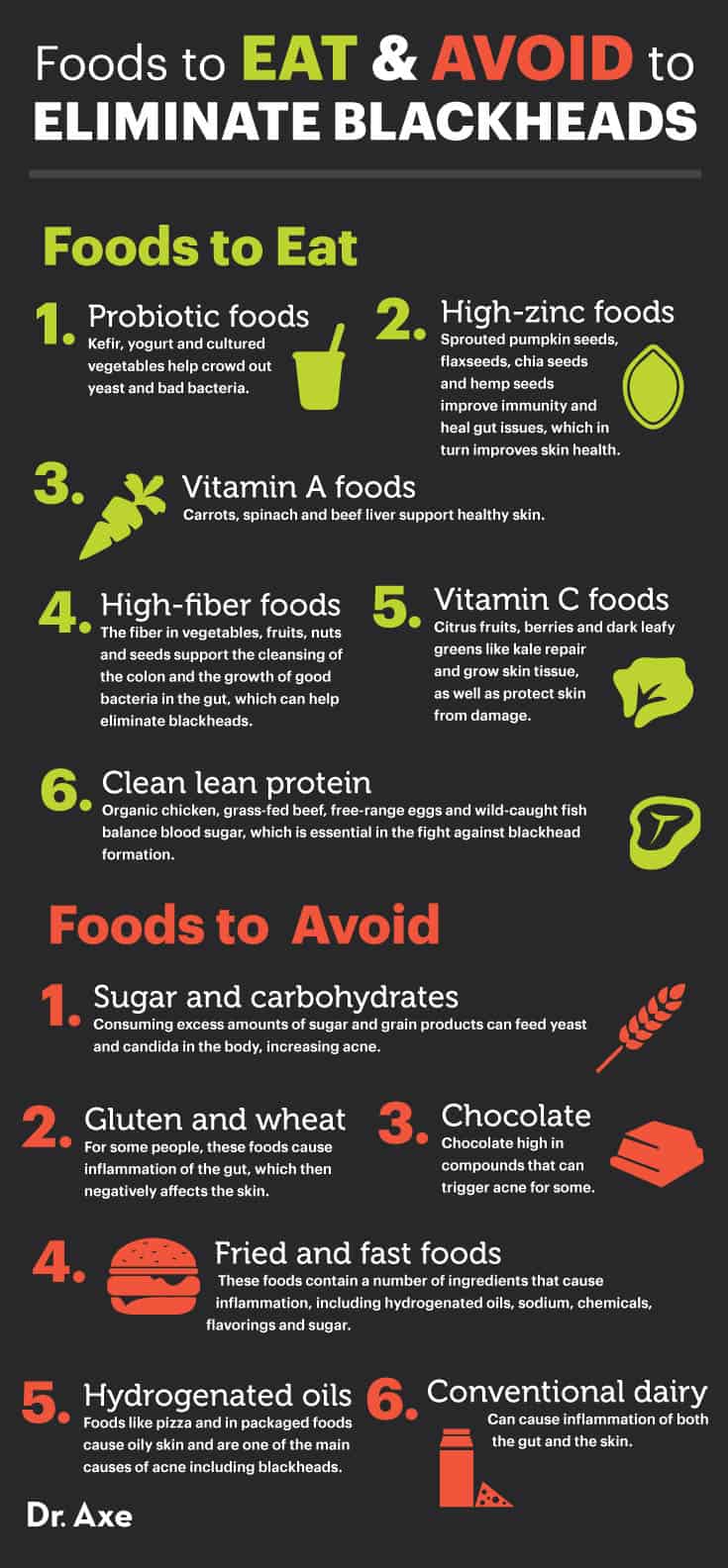Natural Blackhead Removal Options That Won't Damage Your Skin (original) (raw)
Fact Checked
This Dr. Axe content is medically reviewed or fact checked to ensure factually accurate information.
With strict editorial sourcing guidelines, we only link to academic research institutions, reputable media sites and, when research is available, medically peer-reviewed studies. Note that the numbers in parentheses (1, 2, etc.) are clickable links to these studies.
The information in our articles is NOT intended to replace a one-on-one relationship with a qualified health care professional and is not intended as medical advice.
This article is based on scientific evidence, written by experts and fact checked by our trained editorial staff. Note that the numbers in parentheses (1, 2, etc.) are clickable links to medically peer-reviewed studies.
Our team includes licensed nutritionists and dietitians, certified health education specialists, as well as certified strength and conditioning specialists, personal trainers and corrective exercise specialists. Our team aims to be not only thorough with its research, but also objective and unbiased.
The information in our articles is NOT intended to replace a one-on-one relationship with a qualified health care professional and is not intended as medical advice.
December 5, 2023
(49)
- What Are Blackheads?
- Causes
- Natural Blackhead Removal Options
- Blackhead Removal Diet
- Risks and Side Effects

Do you struggle with the mild form of acne known as blackheads? If the answer is “yes,” you’re not alone — and you’re probably wondering all about how to get rid of blackheads, along with blackhead removal techniques.
Blackheads are extremely common, affecting all skin types.
While they may be the least noticeable form of pimples, you’re still probably wondering about blackhead removal (especially if you own one of those magnifying mirrors that make every skin problem look even worse!).
So what are blackheads, and is it even possible to get rid of them once and for all? Are there any home remedies for acne that specifically target blackheads?
Getting rid of blackheads naturally may take a little effort or changes in your lifestyle, but it’s definitely possible to reduce them starting today!
Ad
What Are Blackheads?
Blackheads are technically a type of acne known as a comedo. A comedo is a clogged hair follicle (pore) in the skin.
While there are various types of comedones, they all start with the same situation: plugged-up pores. When oil, dead skin cells or bacteria block our pores, this can result in the formation of a small comedone called a blackhead or a whitehead.
If a blocked pore stays open, the oxygen in the air oxidizes the oils, turning them dark brown or black. These tiny dark spots are called blackheads.
This blackhead creation process is similar to how an apple turns brown when exposed to air. On the other hand, if a blocked pore closes up, then the top of the bump looks more white and is called a whitehead. To the eye, blackheads are typically not raised from the skin, while whiteheads are clearly raised.
Different Types of Acne
There are several different varieties of acne lesions, and you can have one form or a combination of forms at any given time:
- Comedones — Comedones are non-inflammatory acne lesions that are open or closed. Closed comedones, or whiteheads, are small plugged follicles and their contents are not exposed to the skin. Open comedones, or blackheads, are small follicles with dilated openings to the skin. The openings allow oxidation of the debris within the follicle to occur, and this causes the black color.
- Inflammatory acne — When lesions become red and/or tender bumps, they’re called papules. These bumps can become pus-filled, and they are then called pustules. Papules and pustules are inflammatory acne lesions, which start off as comedones.
- Nodular acne — When inflammatory lesions become larger and even more tender, they’re termed nodules.
- Cystic acne — Cysts are deep, fluid-filled lesions, and when these occur along with nodules, the term nodulocystic or cystic acne is used.
Blackheads are most common on your face, especially on your nose and, most specifically, on the sides of your nose. Some people also get blackheads in other areas, such as on their ears, shoulders and back. Unfortunately, blackheads (and whiteheads) can form anywhere there is a hair follicle or pore.

Causes
Blackheads are very common, and sometimes they might just happen with no obvious explanation. However, there are several things that can contribute to the formation of a blackhead:
- Hormones— A major cause of blackheads is fluctuations in your body’s hormones, which commonly take place during puberty as well as during premenstrual syndrome for women. Higher concentrations of certain hormones can cause skin to become more oily. That excess flow of oil can get backed up and then mix with built-up dead skin cells that cannot be shed normally, which then results in a blackhead or hormonal acne.
- Smoking — Women and men who smoke tend to get non-inflammatory blemishes like blackheads and whiteheads. Cigarette smoke contains many unhealthy particles, like nicotine, that have a direct negative impact on the skin that leads to the formation of blackheads. Smoking also inhibits effective treatment of blackheads, so not only are you causing the problem, but you’re preventing it from going away.
- Excess oil production — When skin tends to be on the oily side or overproduces oil for some reason, pores are more likely to become clogged, and blackheads are more likely to form in those clogged pores.
- Makeup and skin care products — Makeup and skin products with artificial colors, fragrances and mineral oil can easily cause clogged pores, causing blackheads to form.
- Poor diet — Fried, sugary and high-carb foods are some of the top culprits when it comes to unwanted blackheads. Too much alcohol or caffeine — particularly caffeine overdose — can also cause problems. Watch for when your blackheads flare up, and think about what you’ve been eating lately.
Natural Blackhead Removal Options
Why not skip all of the commercial and highly unnatural blackhead removal products on the market and go the natural route? It’s sure to provide more gentle, effective and long-lasting results.
Here’s how to get rid of blackheads naturally:
1. Gentle and Effective Cleansing
The first step to remove blackheads naturally? Gentle, daily cleansing.
You may want to try this Homemade Honey Face Wash for Clear Skin. Use a natural cleanser like this each evening before bed, at the least, and, if needed, after workouts.
Refrain from cleansing more often than in the morning, evening and after workouts, because too much cleansing can irritate and dehydrate the skin, causing an overproduction of oil and even more blackheads.
2. Regular Exfoliation
In addition to cleansing, exfoliation is another important part of how to remove blackheads naturally.
Regularly exfoliating the skin is key to keeping these little spots in check since exfoliation scrubs away dead skin cells that can lead to clogged pores. Try using a gentle exfoliating face scrub at least one to two times per week.
When it comes to exfoliation, more is not better, and overdoing it can easily result in more skin issues, especially for those with sensitive skin.
Ad
Baking soda is a cheap and effective exfoliant. Simply combine one teaspoon of baking soda with half a cup of water, and rub it on your face in a circular motion, then rinse.
3. Pore Strips
Wondering how to get rid of blackheads on the nose? Pore strips containing natural ingredients are a great way to perform blackhead removal on the nose and other parts of the face.
Whether store bought or homemade, pore strips are a quick and thorough method of blackhead extraction. You actually see the blackheads being removed. For some, the results really can be quite incredible and satisfying, but don’t get addicted, because they’re not meant for daily use.
Whether you use the blackhead removal strips for your nose (most common), forehead or chin, don’t use them more often than once every three days, with once a week as a good frequency.
4. Clay and Charcoal Masks
Done weekly, a mask containing a high-quality clay (like bentonite clay) or charcoal can work wonders to clean out the pores, pulling out blackheads and leaving skin smoother and less oily than it was before.
You can also try this DIY Blackhead Removal Mask. The key ingredient is gelatin, which can help pull out the debris in clogged pores and act as a natural blackhead remover.
5. Steaming
If you’re trying to remove blackheads, steaming can be a helpful part of your skin care routine. The steam from the hot water can help loosen the blackheads in your pores.
Here’s how to get rid of blackheads with steam:
- Start with a clean face.
- Next, fill a large bowl with boiling hot water, and then let it cool a bit before covering your head with a towel and leaning over the bowl of water for five to 10 minutes.
- When time is up (or you just can’t take the heat anymore), wash your face with cleanser and warm water, and gently pat skin dry.
Remember not to get too close to the hot water or you could burn yourself. You can repeat this once a week or as needed.
6. Witch Hazel
As a natural home remedy for acne, applying witch hazel to blackhead-prone skin can help decrease inflammation and excessive oil production.
As a cleanser, toner and botanical anti-inflammatory, witch hazel is excellent at soothing skin and reducing overproduction of oil.
Another benefit is that it helps unclog pores and reduce the look of pores. (No product can actually shrink pores.)
7. Skin Brushes
If you watch blackhead removal videos online, you’ll see there are many removal tools. One of these blackhead removal products is a mechanical skin brush.
Mechanical skin brushes are used for general cleansing purposes, but they can also be a very effective daily method for reducing blackheads. They act as powerful, deep-cleansing exfoliators, and they can help cleansers do a better job as well.
If you use a skin brush, just make sure you keep it very clean, and replace the heads often (so it doesn’t harbor bacteria and cause more issues).
8. Nightly Makeup Removal (Always!)
This is probably the 8,965th time you’ve heard this, but please don’t go to sleep with your makeup still on! Not only is your face not clean, but it doesn’t breathe while you’re sleeping.
While we’re sleeping, our skin goes into a recovery and regeneration mode. Wash your face before bed, and let your skin do its thing.
9. Keep Your Hands to Yourself
Unfortunately, the more you touch your face (especially with unclean hands), the more prone you are to transfer bacteria and dirt to your pores. This easily triggers blackheads and other breakouts.
Picking and popping blackheads, even with clean hands, is another action to refrain from since, ultimately, you will cause more harm than good (even if you did manage to see some of those blackheads pop out).
Not only can you cause more of these tiny spots as well as other breakouts, but you may be damaging your skin. This can be permanent damage and permanent enlargement of your pores.
Rather than using your hands, you’re better off trying a blackhead removal tool, such as a blackhead vacuum or a blackhead extractor. Make sure to follow product instructions carefully. If in doubt, you can always see an esthetician for professional blackhead extraction.
10. Moisturize Properly
Contrary to popular belief, blackhead-prone or oily skin still needs to be moisturized daily. Using topical products that focus on drying out the skin only makes the skin produce more oil, which just increases blackheads.
Look for moisturizers from natural brands that are non-comedogenic (specially formulated not to cause blocked pores). The fewer the ingredients the better, too, since more ingredients can often mean more opportunities for irritation.
Many conventional moisturizers for acne reduction contain salicylic acid, which can be natural or synthetic. While salicylic acid can be helpful at decreasing various forms of acne, it’s best to get it from natural sources.
Aloe vera is a plant-derived moisturizer that naturally contains salicylic acids, along with many other skin-boosting ingredients, such as vitamins, minerals enzymes and amino acids.
11. Essential Oil Spot Treatment
Another effective blackhead removal DIY involves the use of essential oils, many of which are really excellent for your skin. Tea tree oil, for example, has actually been found to work as well as benzoyl peroxide, a common over-the-counter acne treatment.
A few drops of tea tree essential oil can be applied undiluted directly onto blackheads as an overnight treatment that will kill bacteria and help dissolve blackheads.
If your skin is ultra-sensitive, you can combine a few drops of essential oil with a noncomedogenic carrier oil, like jojoba or argan oil.
Blackhead Removal Diet
Now let’s look at how to get rid of blackheads with what you eat (or don’t eat). By improving your daily diet, you can greatly improve the quality of your skin and potentially decrease or even eliminate blackheads and other forms of acne.
Top Foods
Certain foods can help reduce internal and external inflammation, increase good bacteria in the gut, and have other positive effects on the body, which directly affect the health of our skin. Here are some of the top anti-blackhead foods to eat:
- Probiotic foods — Probiotic-rich foods like kefir, yogurt and cultured vegetables can help crowd out yeast and bad bacteria, which lead to all forms of acne, including blackheads.
- High-zinc foods — Sprouted pumpkin seeds, flaxseeds, chia seeds and hemp seeds are high in zinc. Zinc improves immunity and helps to heal gut issues, which in turn improves skin health. Research shows that internal use of zinc can reduce acne inflammation and even decrease overproduction of sebum.
- Vitamin A foods — Carrots, spinach and beef liver are all high in vitamin A, which supports healthy skin.
- Vitamin C foods — Vitamin C is needed for the repair and growth of all skin tissue in our bodies. It’s also an antioxidant that helps protect our skin from damage. Consume more fruits and vegetables, including citrus fruits, berries and dark leafy greens like kale.
- High-fiber foods — The fiber in vegetables, fruits, nuts and seeds supports the cleansing of the colon and growth of good bacteria in the gut. High-fiber foods also help to balance blood sugar levels, which is another reason why they’re great for skin health.
- Clean protein — Organic chicken, grass-fed beef, free-range eggs and wild-caught fish are all examples of clean, lean protein sources that help balance blood sugar. Research shows that a high-protein, low glycemic-load diet can help fight blackheads and other forms of acne.
Foods to Avoid
A plan for how to get rid of blackheads naturally also includes certain foods you should avoid. In addition to not overdoing it when it comes to alcohol and caffeine, aim to remove or significantly reduce the following:
- Sugar and carbohydrate-rich foods — Research reveals a link between the consumption of refined carbohydrates and acne. Consuming excess amounts of sugar and grain products can feed yeast and candida in the body, increasing all forms of acne, including blackheads.
- Gluten and wheat — For some people, these foods cause inflammation of the gut, which then negatively affects the skin. Try keeping a food journal to see if gluten/wheat is a trigger for your blackheads.
- Chocolate — Chocolate is high in compounds that can trigger acne for some. For instance, in a double-blind, placebo-controlled study of males with a history of acne, researchers found that “the consumption of chocolate correlates to an increase in the exacerbation of acne.” Eliminate chocolate completely if it might be a trigger. If you do consume it, then make sure it’s pure dark chocolate, which has less sugar and more beneficial nutrients.
- Fried and fast foods— These foods contain a number of ingredients known to cause inflammation, including hydrogenated oils, sodium, chemicals, flavorings and sugar.
- Hydrogenated oils — Hydrogenated oil causes oily skin and is one of the main causes of acne, including blackheads. Hydrogenated oils can be found in foods like pizza and in packaged foods that contain soybean oil, corn oil, canola oil and vegetable oil.
- Conventional dairy — Conventional dairy can cause inflammation of both the gut and the skin, which leads to acne. Studies have linked conventional dairy consumption to hormonal changes that contribute to acne.

Risks and Side Effects
Make sure to use essential oils that are 100 percent pure, organic and therapeutic grade. Always perform a patch test before using essential oils on the face, and discontinue use if irritation occurs.
Final Thoughts
- A blackhead is technically a type of acne known as a comedo, which is a clogged hair follicle (pore) in the skin.
- Blackheads are most often seen on the face, especially on the nose.
- Natural remedies for blackheads are plentiful, and blackhead removal is easy to do at home and can really help reduce those small yet annoying little spots.

